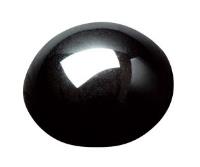 Add My Company
Add My Company
Sign In
Gemstone Focus: Hematite
02-03-2017

Hematite is an opaque stone which has a wonderful dark metallic lustre, similar in many respects to iron pyrite. They both have an iron based composition which can be differentiated by the presence of oxides in the case of hematite, and sulphides in pyrite, or fool’s gold as it is sometimes known. Both can be easily mistaken for precious metals because of their unusual metallic lustre which is not generally exhibited in gemstones.
Hematite can form in one of two ways; it either occurs in large masses with a larger and flatter crystal structure, or as a shorter, rhombohedral formation which is a six faced prism that can be likened to a hexagon. These rhombohedrons have a habit of forming one on top of the other like the petals of a flower which is known as an ‘iron rose’.
In times past both hematite and pyrite were polished to such a highly reflective finish that they were used as mirrors in Mesoamerican culture, which dates back thousands of years. These mirrors were decorative but were also used in the practice of divination, as they were thought to represent a portal into another realm. Such highly reflective pieces of hematite are generally known as ‘specular’, which actually originates from their traditional use in mirrors.
The most commonly available colour of hematite is the dark grey/black version which is often cut en cabochon or fashioned into beads. However there is another highly iridescent version which occurs naturally, displaying the most amazing rainbow of colours, similar in effect to oil on water. This effect can be enhanced by electroplating.
Perhaps one of the most surprising features of hematite is its ability to ‘bleed’, and it is this that has captured the imagination of people for centuries and also where its name is derived (the Greek word for blood is aima). When hematite is cut it reveals a rust coloured powder, which in fact is exactly what it is. This red colouring is down to the partial oxidation of its high iron content, and is one of the most identifiable features of hematite. The red/brown colour is sometimes visible on the surface of the stone but is always present once cut or if it gets wet, so care must be taken when wearing and storing hematite. It is also worth noting that hematite is an extremely porous stone, so anything which comes into contact with its surface will be absorbed and can potentially damage the overall appearance and colouring.
As I have already mentioned, hematite is generally available to buy in highly polished cabochon stones, beads and rough tumbled nuggets. It is also available as lightly facetted beads and stones which look very effective. Unfortunately these facetted stones have limited durability due to the relatively ‘soft’ composition; measuring only 6.5 on Moh’s scale of hardness means they are very ‘scratchable’.
There is no denying the drama of hematite, and its popularity in men’s jewellery is testament to its dark and edgy beauty which is quite unlike anything else. Inexpensive to buy, it can be used to contrast or enhance other stones and objects which make it an interesting material to experiment with.
If you are not already a fan, why not give hematite a try and see what new effects you can create? To get started, explore the full range of Hematite gemstones or semi precious beads from Cooksongold today.
For more information on Gemstone Focus: Hematite talk to Cooksongold
Enquire Now
List your company on FindTheNeedle.

